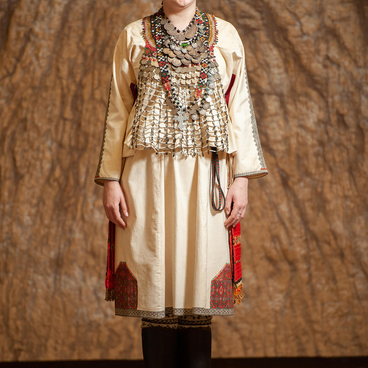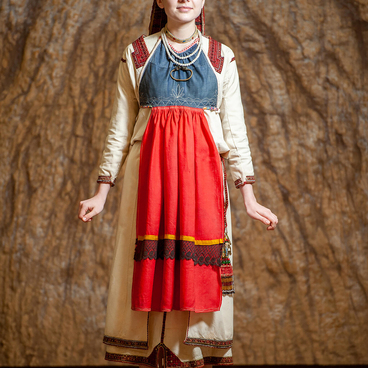The range of varieties of Mordovian national clothing is impressive in its originality of artistic traditions. The unique character and special value of traditional Mordovian costume were based on the handmade nature of its elements and the close relationship to the personality of the maker. The shapes of headdresses, coloring of decorations, unique techniques of embroidery underline the local peculiarity of the costume. The distinctive features of the costume of the Kuznetsky group are its multi-layered design, restrained colors and the predominance of white.
The expressive silhouette, emphasized by the smooth lines of the garment and the shape of the headdress, creates a touchingly luminous image. The undershirt was almost always concealed by an open garment and an apron. The material for the shirt, which was called panar or palya here, was usually coarse homespun canvas.
A tunic-like garment — panzhat — decorated with a geometric pattern on the chest, was worn over the shirt. This open canvas piece of clothing was the main part of the costume and had a number of distinctly different variations. The cut of the open clothes was the same and was a direct analog of the open clothes of the Mordovians of Gorodisschensky uyezd. Besides the name panzhat, the term rutsya was used in the villages where the Moksha population lived.
According to local traditions, panzhat was worn with an apron — ikelga patsya. It was made of monochrome white cashmere and decorated at the hem with a welt and a lace ribbon for a festive costume. The apron was belted high and the hem was equal to the length of the shirt.
Of particular interest is the trapezoidal headdress. This is a wide cap with a long blade descending to the back. The front and the back of the headpiece are covered with dense embroidery, made in the technique of unique carpet stitches. The most elegant attire was worn by a young woman in the first years of marriage. It emphasized her status and indicated the reproductive age of the owner. In the course of life, the decor of headdresses changed strictly corresponding to the age of the wearer. A young woman’s headdress was distinguished by dense embroidery without gaps, abundance of sewn decoration materials — beads, braid, and sequins. An elderly woman wore simplified embroidery or her headdress was sewn from homespun canvas — pestryad.
The expressive silhouette, emphasized by the smooth lines of the garment and the shape of the headdress, creates a touchingly luminous image. The undershirt was almost always concealed by an open garment and an apron. The material for the shirt, which was called panar or palya here, was usually coarse homespun canvas.
A tunic-like garment — panzhat — decorated with a geometric pattern on the chest, was worn over the shirt. This open canvas piece of clothing was the main part of the costume and had a number of distinctly different variations. The cut of the open clothes was the same and was a direct analog of the open clothes of the Mordovians of Gorodisschensky uyezd. Besides the name panzhat, the term rutsya was used in the villages where the Moksha population lived.
According to local traditions, panzhat was worn with an apron — ikelga patsya. It was made of monochrome white cashmere and decorated at the hem with a welt and a lace ribbon for a festive costume. The apron was belted high and the hem was equal to the length of the shirt.
Of particular interest is the trapezoidal headdress. This is a wide cap with a long blade descending to the back. The front and the back of the headpiece are covered with dense embroidery, made in the technique of unique carpet stitches. The most elegant attire was worn by a young woman in the first years of marriage. It emphasized her status and indicated the reproductive age of the owner. In the course of life, the decor of headdresses changed strictly corresponding to the age of the wearer. A young woman’s headdress was distinguished by dense embroidery without gaps, abundance of sewn decoration materials — beads, braid, and sequins. An elderly woman wore simplified embroidery or her headdress was sewn from homespun canvas — pestryad.




